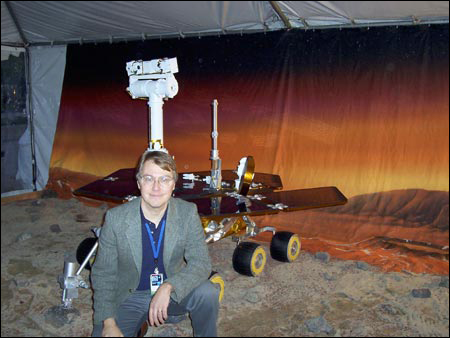Water makes biological splash on Mars
Harvard’s Andrew Knoll looks for signs of Martian life

Finding new signs of water on Mars was not unlike finding a needle in a haystack. Now scientific explorers and their robot helpers face a trickier task, looking for life, a needle they are not even sure is there.
If life did exist, don’t expect traces of little green primates or even little green bugs. According to Andrew Knoll, Fisher Professor of Natural History at Harvard University, “Any life that evolved was probably very simple, on the level of bacteria and less than the width of a human hair in size. You’d need a microscope to see it.”
The National Aeronautics and Space Administration invited Knoll to participate in the Mars rover expedition from the control center at the Jet Propulsion
Andrew Knoll describes how life in general, and bacteria in particular, arise on a new planet in his recent book, ‘Life on a Young Planet’ (Princeton University Press).
Laboratory in Pasadena, Calif. Here, he and his colleagues see new parts of the Red Planet every day through the camera eyes of two robots. Knoll has traveled all over Earth looking for the earliest living things, and NASA hoped he might spot a site like those he has seen on our Blue Planet.
He did. In southwest Spain, by an ancient river, Knoll has worked on deposits of iron and sulfur minerals very similar to those discovered on Mars. One uncommon iron mineral, called jarosite, forms only in the presence of water – acidic water.
Sulfur, originally belched up by volcanoes billions of years ago, is believed to have combined with and been carried into basins by water. This sulfuric acid then joined with metal ions to form the sulfur minerals found by the robot Opportunity.
Its cameras also photographed tiny pocks where mineral crystals formed in sediments deposited by water. The crystals later dissolved, leaving what geologists call “vugs,” which can be seen in many places on Earth.
In the Spanish river, creatures now thrive in acidic water. But that doesn’t convince Knoll that life ever existed on Mars. Getting samples of rocks with fossilized bacteria in them would be the only way to know for sure. But the first mission to bring back rock samples is not scheduled until the next decade.
Evidence of water activity has also been found on the other side of Mars, by Spirit, Opportunity’s twin. So far, however, the amount seems to be much less than in the once-drenched surface explored by Opportunity.
Good luck landing
“In one way, looking at the geology of Mars is an extension of what I have been doing for the past 30 years,” says Knoll, 52. “In another way, it’s like entering a whole new realm of science. It is very exciting, a once-in-a-lifetime experience.”
Knoll cites the great good luck in landing a robot only about 13 feet from the kind of rock layers deposited by water. “Such layers are the kind of library I consult when looking for signs of early life on Earth,” he says with a smile. “Right now, we don’t know how much water was on Mars or when. What we need to do next is determine as much as we can about the history of water on that planet.”
The flat plains in the equatorial region of Mars where the rover robots landed are not the only place where water existed or still exists. Ice caps now cover both poles. And, in the past, water may have bubbled up from underground reservoirs penetrated by the impact of meteorites. Future technology will most probably produce robots capable of landing in such places. Opportunity and Spirit could only set down on flat areas, and their solar batteries keep them within 10 degrees of the equator where sunlight is at a maximum. Knoll imagines higher-tech Marsbots with more range and dexterity.
Astronauts on Mars
What about sending astronauts to look for evidence of life? In January, President Bush called for manned landings on the moon by 2020, and using lunar bases as a steppingstone to Mars at an unspecified time. Asked what he and other scientists working with the Mars rovers think about this, Knoll said, “We haven’t had a lot of discussion about it. It’s too tangential to the work at hand. We’re trying to understand what we are seeing everyday. We don’t have much time to think about being part of history now, or what the future exploration might be like.”
Scientists seem to be of two minds about walking on Mars, according to Knoll. Some see it as manifest destiny, others as an expensive stunt. “Robots should be technically mature by the time we’re ready to send people to Mars, Knoll notes. “At that time, we’ll have to decide whether the nation would be better off sending humans or sophisticated robots.”
Knoll has searched some of the most inaccessible spots on Earth for signs of the planet’s earliest inhabitants. One place he hasn’t been is the bed of the deep ocean where a weird assortment of plants and animals lives in cold darkness and acidic waters. Asked if he’d like to continue his search on Mars, Knoll answered, “Not really. I’d much rather go to the bottom of the ocean.”




